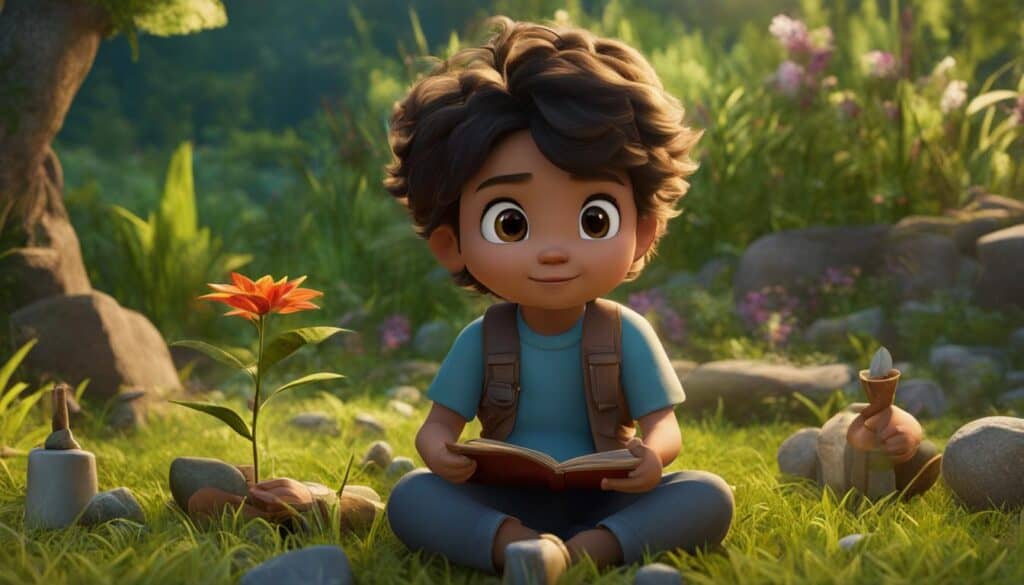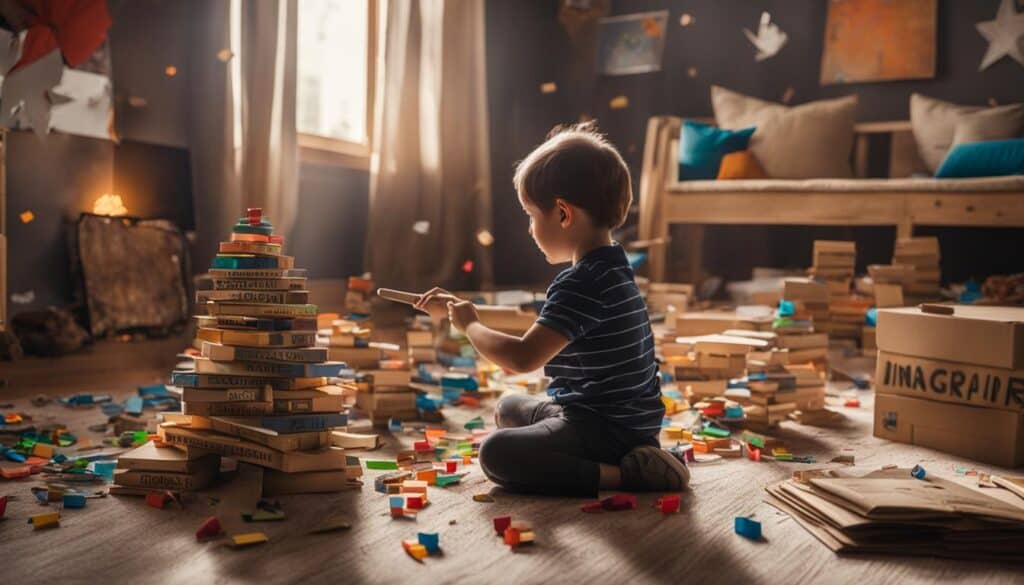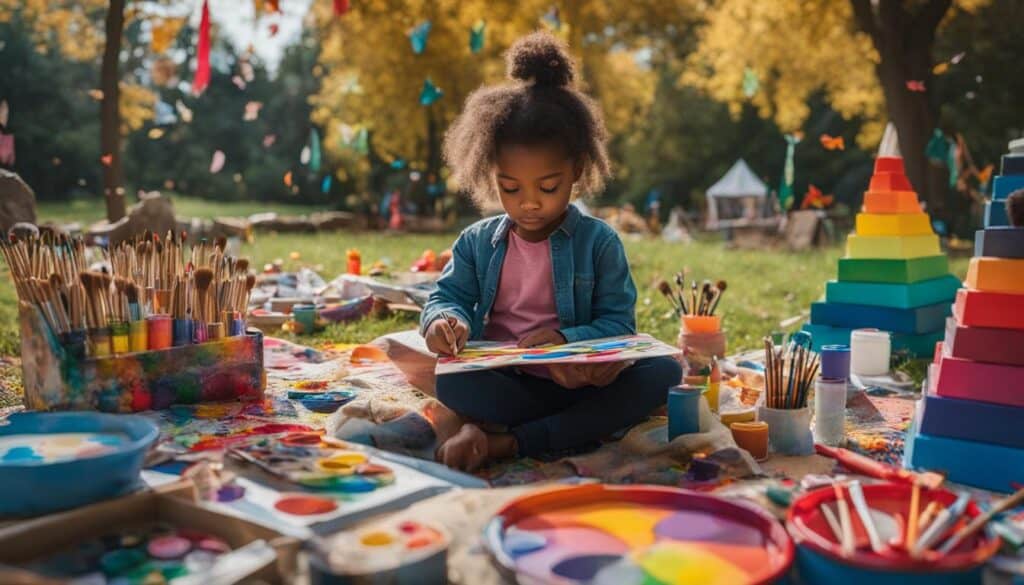Creative play is a vital aspect of childhood that fosters imagination and enhances the development of important skills in children. By engaging in imaginative play, children can tap into their creativity, problem-solving abilities, and social skills. It allows them to explore various roles, create their own worlds, and express themselves in unique ways. Creative play is essential for nurturing creativity and imagination in kids.
Key Takeaways:
- Creative play is crucial for developing imagination and important skills in children.
- Imaginative play allows children to explore various roles, create their own worlds, and express themselves.
- It fosters creativity, problem-solving abilities, and social skills in children.
- Engaging in creative play nurtures imagination and prepares children for future challenges and opportunities.
- Supporting and encouraging creative play is essential for adults to unlock the full potential of a child’s imagination.
The Power of Pretend Play in Child Development

Pretend play, also known as imaginative play, is a powerful tool for child development. It allows children to engage in unstructured play where they can create their own stories, characters, and worlds. Through pretend play, children develop essential social and emotional skills, such as teamwork, communication, and empathy. It also supports cognitive development by encouraging problem-solving, creativity, and critical thinking. Additionally, pretend play promotes language development as children engage in role-playing and use language in different contexts.
Imaginative play is a gateway for children to explore their creativity and imagination. It provides them with the freedom to invent and reinvent scenarios, embody different roles, and engage in collaborative play with their peers. Through pretend play, children learn to negotiate, cooperate, and take turns, which are vital social and emotional skills. They develop empathy and understanding as they immerse themselves in different perspectives and engage in pretend conversations. Pretend play also helps children cultivate their cognitive abilities by solving problems, making decisions, and embracing uncertainty.
Moreover, pretend play fuels language development in children. As they role-play different characters and situations, children have the opportunity to practice expressing themselves, using new vocabulary, and experimenting with language in a safe and imaginative environment. Pretend play encourages language acquisition and fluency as children engage in imaginative conversations and creative storytelling. It fosters their ability to communicate effectively and expands their linguistic capabilities.
In addition to its social, emotional, and cognitive benefits, pretend play sparks creativity in children. By imagining and creating their own worlds, children develop their imaginative thinking, resourcefulness, and originality. They learn to think outside the box, explore different possibilities, and generate unique ideas. Pretend play allows children to unleash their creativity and express their thoughts, emotions, and desires through play.
Overall, pretend play is a catalyst for holistic child development. It nurtures social and emotional skills, enhances cognitive abilities, promotes language development, and fosters creativity in children. By providing ample opportunities for pretend play, parents, caregivers, and educators can empower children to embark on imaginative journeys, explore their unique perspectives, and develop the skills they need to thrive in the world.
Benefits of Dress-Up Play and Role-Playing

Dress-up play and role-playing are not only fun but also provide numerous benefits for children’s development. When children engage in dress-up play and role-playing, they have the opportunity to explore different characters and scenarios, which contributes to their socialization skills, language development, creativity, and problem-solving abilities.
During dress-up play, children get to dress up as their favorite characters or even invent their own unique personas. This type of play encourages socialization skills as children learn to take turns, cooperate, and communicate effectively. As they interact with their playmates, they develop important social skills that are crucial for building positive relationships and navigating social situations in the real world.
Additionally, dress-up play promotes language development in children. When children engage in role-playing, they experiment with different words, phrases, and dialogues to express themselves as various characters. This expands their vocabulary, improves their verbal skills, and encourages them to use language in diverse contexts. Dress-up play provides a platform for children to explore different roles and practice using language creatively and effectively.
“Dress-up play and role-playing are not only fun but also provide numerous benefits for children’s development.”
Moreover, dress-up play stimulates creativity and problem-solving skills. When children immerse themselves in their pretend roles, they are constantly coming up with imaginative ideas and solutions. They engage in imaginative problem-solving and use their creativity to address different scenarios within their play. Whether it’s creating a story or finding a solution to a dilemma, dress-up play fosters critical thinking and encourages children to think outside the box.
Examples of dress-up play and role-playing activities:
- Imitating occupations such as doctors, firefighters, chefs, or astronauts.
- Pretending to be characters from favorite books, movies, or TV shows.
- Imagining themselves as superheroes, princesses, or explorers.
- Inventing their own characters and narratives.
- Organizing dress-up parties or performances.
Integrated Image Example:
Encouraging World Building and Imagination

Encouraging world building and imagination in children is a wonderful way to nurture their creativity and provide them with a platform for self-expression. By allowing children to take the lead in constructing their own imaginative worlds, we empower them to develop their creative thinking skills and effectively express their unique ideas and preferences.
World building is a form of play that stimulates a child’s imagination and encourages them to think outside the box. It allows them to create their own stories, characters, and scenarios, providing endless possibilities for exploration and discovery. Through world building, children develop the ability to envision new worlds and translate their ideas into tangible creations.
When children engage in world building, they have the freedom to establish their own rules, settings, and characters. This process fosters self-expression, as they are empowered to bring their imagination to life in their own unique way. Whether they imagine a futuristic city, a mystical land, or an underwater kingdom, the act of world building allows children to unleash their creativity and bring their wildest dreams to fruition.
World building is not just about creating a physical space; it goes beyond that. It is about cultivating a child’s capacity to think creatively, problem-solve, and envision possibilities. Through world building, children learn to navigate complex systems, collaborate with others, and make choices based on their imaginative ideas.
The benefits of world building and imagination extend far beyond the realm of play. These skills lay the foundation for future success in various areas of life, from academic achievement to professional innovation. By encouraging world building in children, we equip them with the tools they need to think critically, adapt to new situations, and approach challenges with a creative mindset.
As parents, teachers, or caregivers, it is important to provide children with opportunities for world building and imagination. This can be done through open-ended play, where children have the freedom to explore, create, and problem-solve without the constraints of predefined outcomes. By fostering an environment that nurtures imagination, we empower children to become lifelong learners, confident individuals, and active participants in shaping the world around them.
Using Real-Life Scenarios for Pretend Play

Incorporating real-life scenarios into pretend play can have a positive impact on children’s development. By engaging in imaginative play based on real-life situations, such as going to the doctor’s office or starting a new school, children can gain a better understanding of these experiences and build the confidence to handle them in real life.
Pretend play that mirrors real-life scenarios not only sparks children’s imagination but also helps them develop essential social skills. As they role-play different situations, children learn how to interact with others, cooperate, and navigate social dynamics.
Furthermore, using real-life scenarios in pretend play encourages problem-solving abilities. Children are presented with challenges and obstacles they may encounter in the real world, stimulating their problem-solving skills and fostering critical thinking.
This type of play also provides a safe and comfortable environment for children to practice and develop adaptability. They can experiment with different strategies and approaches within the context of the pretend scenario, building resilience and flexibility.
By incorporating real-life scenarios into pretend play, children not only have fun and engage their imagination but also acquire valuable social skills, problem-solving abilities, and confidence. It is an effective way to prepare children for real-life situations and equip them with the necessary skills to navigate the world around them.
Encouraging Creativity Through Art Activities

Art activities provide children with a wonderful opportunity to nurture their creativity and self-expression. Through engaging in activities such as painting, drawing, sculpture, and collage, children can explore their imagination and create unique works of art that reflect their inner thoughts and ideas. Art allows children to think outside the box and experiment with different materials, colors, and techniques, fostering their creative thinking skills.
Engaging in art activities also supports the development of fine motor skills. As children manipulate art materials and tools, they enhance their hand-eye coordination, dexterity, and control. These skills are crucial for tasks such as writing, cutting, and tying shoelaces. By engaging in art, children refine their fine motor skills, which are essential for their overall development.
Furthermore, art provides a powerful outlet for self-expression. Children can use art as a means to communicate their feelings, thoughts, and ideas in a visual and tangible form. It allows them to express themselves freely, without limitations or judgment. Through art, children can explore their emotions and gain a deeper understanding of themselves and the world around them.
Art activities also promote critical thinking and problem-solving. When children engage in art, they are faced with choices and challenges that require them to make decisions and find solutions. They may encounter difficulties such as choosing colors that complement each other in a painting or finding ways to create a desired shape in a sculpture. By navigating these challenges, children develop their problem-solving skills and learn to approach situations with creativity and flexibility.
To encourage creativity through art activities, provide children with a variety of art materials, such as paints, brushes, markers, clay, and paper. Create a dedicated space for art exploration where children can freely express themselves. Encourage open-ended art projects that allow for interpretation and personal expression. By embracing art as a tool for creativity and self-expression, we empower children to unleash their imaginations and develop lifelong artistic skills.
The Role of Nature in Nurturing Imagination

Spending time in nature plays a crucial role in nurturing a child’s imagination. The ever-changing natural environment offers numerous opportunities for children to explore, discover, and tap into their imaginative abilities. Outdoor play provides a perfect setting for unstructured play, problem-solving, and creative thinking. Children can build forts, create designs using natural materials, and observe the beauty of the world around them, igniting their imaginations and encouraging them to think outside the box.
Research suggests that exposure to nature positively impacts a child’s cognitive development, creativity, problem-solving skills, and overall well-being. Studies have shown that outdoor play enhances children’s cognitive abilities, allowing them to think critically, make decisions, and find novel solutions to challenges. Nature provides a sensory-rich environment that stimulates a child’s senses and encourages them to explore, experiment, and engage in imaginative play.
When children connect with nature, they develop an appreciation for the natural world, fostering a sense of wonder and curiosity. Through outdoor play, they can experience the wonders of the environment firsthand, observe plants, animals, and natural phenomena, and develop a deeper understanding of the world around them. This connection with nature sparks their imagination and enhances their creativity as they draw inspiration from the natural elements.
The captivating beauty of nature serves as a limitless playground for a child’s boundless imagination.
Outdoor play in nature also provides opportunities for open-ended exploration and problem-solving. Children can engage in activities like building forts, creating imaginary worlds, and navigating natural obstacles, which require them to think creatively and adapt to different situations. The freedom and flexibility of outdoor play allow children to develop their problem-solving skills organically, as they encounter and find solutions to the challenges present in nature.
Furthermore, spending time in nature promotes physical activity, which has a positive impact on both physical and mental well-being. Outdoor play allows children to engage in physical activities like running, climbing, and exploring, which not only supports their overall development but also enhances their mood and sense of happiness.
In summary, nature serves as a powerful catalyst for nurturing a child’s imagination. By providing opportunities for outdoor play, we encourage children to explore, imagine, and engage in unstructured, creative activities that contribute to their cognitive, emotional, and social development. Nature offers a limitless canvas for children to express their imaginations, problem-solve, and develop their unique perspectives of the world.
The Importance of Unstructured Playtime

Allowing children unstructured playtime is essential for nurturing their imagination and fostering creativity. Unstructured play provides children with the freedom to explore their interests, ideas, and imagination without specific rules or guidelines.
During unstructured playtime, children have the opportunity to engage in activities that spark their curiosity and ignite their imaginations. They can create their own games, invent imaginary worlds, and explore different roles and perspectives.
This type of play allows children to tap into their creativity and problem-solving skills. Without the confines of structured activities, they are free to think outside the box and develop their own unique solutions to challenges they encounter.
Unstructured playtime is a valuable downtime for children, allowing them to relax and recharge their mental and emotional energy. It provides a break from the structured routines of their daily lives and offers an outlet for self-expression and self-directed play.
During unstructured playtime, children are not bound by time constraints or external expectations. They can take the lead in their play, follow their interests, and actively engage their imaginations. This type of freedom fosters creativity and allows children to fully immerse themselves in their play experiences.
Unstructured playtime also promotes the development of essential life skills. Children learn how to negotiate, problem-solve, and navigate social interactions through play. They learn to take turns, cooperate, and communicate effectively with others.
By providing unstructured playtime, adults can support children’s overall development and well-being. It is important to create a safe and nurturing environment where children feel empowered to explore their imagination and enjoy the freedom of unstructured play.
The Role of Language Development in Imaginative Play

Imaginative play plays a significant role in language development in children. Through pretend play scenarios, children have the opportunity to practice their verbal skills, expand their vocabulary, and learn new phrases and words in different contexts.
During imaginative play, children engage in conversations with themselves or with their playmates, creating stories and scenarios. These interactions provide them with valuable opportunities to develop their communication skills and learn how to express themselves effectively.
Using language in creative and imaginative ways helps children connect words with thoughts, ideas, and emotions. For example, when pretending to be a doctor treating a patient, children can learn medical-related vocabulary and practice using it in a meaningful context.
Furthermore, imaginative play encourages children to use language creatively. They may create new words, use exaggerated expressions, or adopt different voices and accents to fit their pretend roles. This playful use of language fosters their creativity and helps them explore the boundaries of verbal expression.
Research has shown that children who engage in imaginative play have better language skills, including a larger vocabulary and stronger verbal comprehension. By engaging in this type of play, children naturally expose themselves to a wide range of words and phrases, supporting their language development.
In summary, imaginative play serves as a rich environment for language development in children. It allows them to practice their verbal skills, expand their vocabulary, and learn how to communicate effectively. By encouraging imaginative play, parents and caregivers can support children’s language development while providing a fun and engaging way for them to express themselves.
The Relationship Between Imagination and Problem-Solving

Imagination and problem-solving are closely intertwined. When children engage in imaginative play, they are given the opportunity to think creatively and come up with unique solutions to problems and challenges. By creating imaginary scenarios and characters, children actively practice critical thinking and develop their problem-solving skills.
Imaginative play encourages children to see things from different perspectives and approach problems in innovative ways. It fosters a mindset of curiosity and exploration, which are essential for problem-solving in all aspects of life.
Through imaginative play, children learn to think outside the box and consider alternative solutions, boosting their creative thinking abilities. They develop the flexibility to adapt their thinking and approach according to the circumstances, acquiring invaluable critical thinking skills that will benefit them throughout their lives.
“Imagination is more important than knowledge. For knowledge is limited, whereas imagination embraces the entire world, stimulating progress, giving birth to evolution.” – Albert Einstein
Imaginative play also enables children to experiment, take risks, and learn from their mistakes in a safe and controlled environment. This process encourages them to develop their problem-solving skills and reinforces their confidence in their ability to tackle challenges.
Furthermore, imaginative play nurtures a child’s ability to think critically by stimulating their curiosity and encouraging them to explore new ideas and possibilities. It challenges children to find innovative solutions and encourages them to test different strategies, fostering their problem-solving skills.
In summary, imagination and problem-solving are interconnected abilities that children can develop through imaginative play. By engaging in creative and imaginative thinking, children enhance their critical thinking and problem-solving skills, allowing them to approach challenges with ingenuity and innovation.
The Long-Term Benefits of Fostering Creativity in Children

Fostering creativity in children through imaginative play and creative activities has long-term benefits for their development. By encouraging children to think creatively and express themselves imagitatively, we are cultivating their ability to innovate and adapt in various aspects of their lives.
Creative thinking and problem-solving skills acquired through imaginative play are highly valuable in academic, professional, and personal contexts. When children engage in imaginative play, they learn to think outside the box, explore different possibilities, and come up with unique solutions. This fosters their ability to approach challenges with innovative strategies, a skill that will benefit them throughout their lives.
Furthermore, fostering creativity in children nurtures their capacity for adaptability. Creative individuals are more open to change and are better equipped to navigate the evolving world around them. They are able to explore new ideas, embrace unfamiliar situations, and find creative solutions to unexpected problems.
As children develop their creativity through imaginative play, they also enhance their lateral thinking abilities. This type of thinking allows them to make connections between different concepts and apply knowledge from one context to another. The ability to think creatively and connect seemingly unrelated ideas is vital for innovation and problem-solving in today’s rapidly changing world.
In addition to the cognitive benefits, fostering creativity in children has a profound impact on their emotional and social well-being. Through imaginative play, children learn to express their emotions, empathize with others, and develop stronger social skills. They also gain confidence in their ability to express themselves creatively, which can positively influence their self-esteem and overall mental health.
The long-term benefits of fostering creativity in children cannot be overstated. By nurturing their creativity through imaginative play and providing opportunities for creative expression, we are preparing the next generation to thrive in a world that demands innovation and adaptability.
The Role of Adults in Nurturing Imagination
Adults play a crucial role in nurturing the imagination of children. By providing opportunities for creative play, engaging in imaginative activities together, and supporting children’s ideas and expressions, adults can help cultivate a child’s imagination.
Encouraging open-ended play allows children to explore their imagination freely. By providing materials and props, adults can inspire children to create and envision new worlds. Allowing children to take the lead in their imaginative play empowers them to express their creativity and develop problem-solving skills.
Adults can serve as positive role models by demonstrating the value of imagination and creativity through their own actions and behaviors. By engaging in imaginative play alongside children, adults not only encourage their creativity but also strengthen the bond between adult and child.
Providing opportunities for children to engage in creative activities, such as painting, storytelling, or building, supports their imagination and nurtures their creative thinking. Adults can create a nurturing environment that fosters imagination by setting aside dedicated time for creative play and ensuring a variety of materials and resources are available.
By fostering creativity in children, adults enable them to explore their interests, develop their problem-solving abilities, and envision a world full of possibilities. Adults have the power to inspire and support the growth of a child’s imagination, providing them with the tools and opportunities needed to thrive.
The Importance of Adult Guidance
Adult guidance is essential in nurturing imagination. By actively participating in imaginative play and encouraging children to explore their ideas, adults can help expand a child’s imaginative capacity. Through gentle guidance and support, adults can inspire children’s creativity and provide a safe space for their imagination to flourish.
“Creativity is intelligence having fun.” – Albert Einstein
Albert Einstein’s quote emphasizes the importance of creativity and its connection to intelligence. By fostering imagination in children, adults not only nurture their creative potential but also foster their cognitive development, critical thinking skills, and problem-solving abilities.
- Provide open-ended materials and resources for creative play
- Engage in imaginative activities together
- Encourage children’s ideas and expressions
- Allow children to take the lead in their play
- Model the value of imagination through your own actions
By actively supporting and encouraging children’s imagination, adults can play a vital role in their development, helping them to become imaginative, creative, and innovative individuals.
Conclusion: Unlocking the Power of Creative Play
Creative play is a powerful tool that unlocks a child’s imagination and fosters their overall development. Through imaginative play, children have the opportunity to explore their creativity, develop essential skills, and express themselves in unique ways. The act of engaging in creative play is crucial for child development, as it enhances cognitive, social, and emotional well-being.
By providing opportunities and support for creative play, adults can play a significant role in nurturing a child’s imagination. Encouraging children to engage in imaginative activities and providing them with the necessary materials and props enable them to fully explore their creative potential.
It is important to recognize that fostering creativity in children has long-term benefits. The skills developed through imaginative play, such as problem-solving, critical thinking, and adaptability, are highly valuable in various aspects of life. By encouraging creative play, we are equipping children with the tools they need to become innovative and adaptable individuals in the future.
Unlocking the power of creative play is a collaborative effort between children and adults. By embracing and nurturing a child’s imagination, we can unlock their full potential, fostering their growth and development. Let us provide them with the opportunities and support they need to engage in creative play, unlocking their imagination and setting them on a path towards a bright and imaginative future.
 Fullersears
Fullersears





